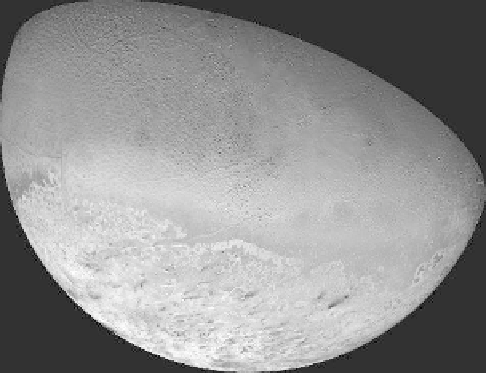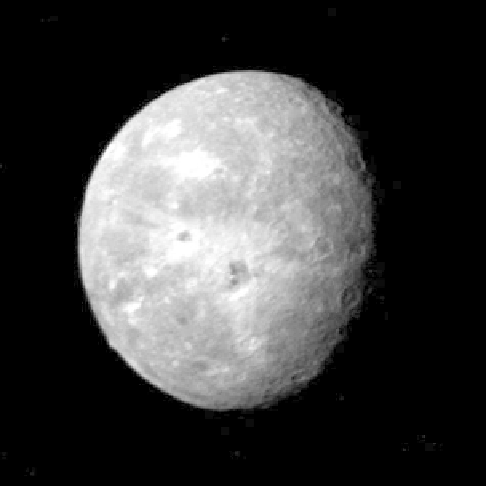Geology Reference
In-Depth Information
Figure 10.11. AmosaicofVoyager images for Triton, Neptune
'
s
largest moon. The so-called cantaloupe terrain of Monad
Regio is on the top half of the image, while the smooth
plains of Uhlanga Regio are on the bottom (NASA Voyager
PIA00317).
Figure 10.10. A Voyager image of Oberon, Uranus
second largest
moon, with a diameter of 1,522 km; the dark feature at the center
of the image is the
'
floor of Hamlet, an impact crater 206 km in
diameter that exhibits bright ejecta rays (NASA Voyager
PIA00034).
consider Triton to be an object gravitationally captured
by Neptune. Since Triton is a retrograde satellite, its orbit
is slowly decaying, or being pulled inward, toward
Neptune. No doubt, in the process of its capture, Triton
would have experienced enormous tidal stresses, leading
to internal heating and likely differentiation. Given its
overall density, it is thought to have a rocky core sur-
rounded by a water mantle, parts of which could be liquid,
and a surface crust of ices composed of methane and
nitrogen, plus frosts of water.
Voyager images reveal a fascinating set of terrains on
Triton, the most prominent being an older rugged unit,
informally called cantaloupe terrain due to its fanciful
resemblance to a melon skin (
Fig. 10.11
), and younger
plains that are relatively smooth. The cantaloupe terrain
includes irregular pits and bumps that could re
ect extru-
sion and deformation of ice onto the surface. Linear
features include ridges and grooves (
Fig. 10.12
)re
ecting
deformation of the crust and possibly additional extrusion
of ice onto the surface. This terrain is pock-marked
by impact craters, most of which are found on the leading
hemisphere of Triton and have about the same size
-
frequency distribution as that of lunar maria. The lack of
larger impact craters and the absence of heavily cratered
units suggest that even the oldest terrain on Triton is geo-
logically young.
Smooth plains cut across the rugged cantaloupe ter-
rain and nearly lack impact craters, indicating youth.
Many of
of some craters are dark, which could represent penetra-
tion into a dark substrate. In addition to craters, Oberon
'
s
surface is marked by chasmata and scarps that re
ect
crustal extension. The largest feature seen is Mommur
Chasma, which is 537 km long and is found in the equa-
torial region.
10.4 Neptunian moons
Neptune has 13 known satellites, six of which were dis-
covered in Voyager data and three of which were discov-
ered more recently from ground-based telescopic
observations. The largest, Titan, is in the same size class
as Earth
is Moon and is in a retrograde orbit. Outward from
Titan, six of the moons are irregular satellites with highly
inclined orbits and are thought to be captured objects.
Inward from Titan, the other six moons are in prograde
orbits and might have formed directly in association with
Neptune. Many of these latter moons are within the ring-
arcs and might be responsible for contributing material to
the rings.
Triton has a density of 2.1 g/cm
3
, the highest of all the
outer planet satellites, suggesting that it is about one-third
ice and two-thirds rocky material. Most planetologists
'
the smooth plains have irregular-shaped





